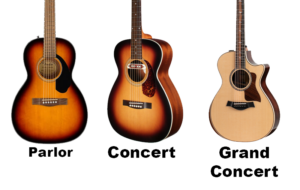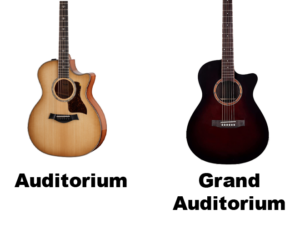Uncategorized
How to Play THE BEATLES’ “Come Together” on the 3-String Guitar
Tune up, plug in, and rock out to one of the Beatles’ most classic and riff-laden masterpieces. This arrangement is specifically for the 3-string guitar and was arranged to be played using a finger slide. It can, however, be played note-by-note whether you use a slide, or fret the notes without a slide.
The Tablature below corresponds to the video performance above.
The tuning for this song is Open G Tuning (G-D-G). To achieve this tuning, string your 3-string guitar up with the A, D, & G string from a standard 6-string guitar pack, and tune the strings to the notes G-D-G.
The key to playing this song correctly, is to think of it as two separate guitar parts that are being played simultaneously. The right-hand thumb is playing a bassline on each downbeat, and the rest of the fingers on the right hand pick the melody notes. It’s important to isolate the two parts and practice them separately in order to master this technique. This style of playing a melody and bassline simultaneously is popular in the “Mississippi Hill Country Blues” style of picking. To check out a complete lesson on this style CLICK HERE.
Thanks for keeping the Roots alive, and don’t forget to click “FOLLOW” on the right-hand side of this page to stay up-to-date with new lessons and articles!
The 3-String Guitar used in this video lesson was crafted by:
Bill Turner of Wunkywerks Guitars
Etsy Store: https://www.etsy.com/shop/WunkywerksGuitars
Email: Wunkywerksguitars@gmail.com

Uncategorized
Acoustic Guitar Sizes: Finding Your Perfect Fit
Have you ever wondered how the size of an acoustic guitar affects its sound? From the intimate, focused tones of a parlor guitar to the deep, resonant sound of a jumbo, the size and shape of an acoustic guitar can have a profound impact on its sonic characteristics.”
In this article, we’ll explore acoustic guitar sizes, their variations, and how to choose the perfect size that suits your needs.
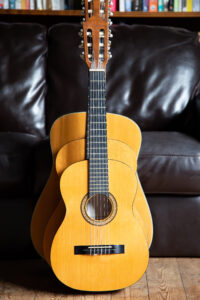 Understanding Acoustic Guitar Sizes: A Musical Puzzle
Understanding Acoustic Guitar Sizes: A Musical Puzzle
Acoustic guitar sizes refer to the dimensions and proportions of the guitar body, which significantly influence the instrument’s tonal characteristics, projection, and playability.
Just like pieces of a musical puzzle, different sizes create distinct voices that cater to various playing styles and preferences.
The Spectrum of Acoustic Guitar Sizes
Acoustic guitars come in several sizes, each with its unique qualities and attributes. Let’s explore some common acoustic guitar sizes and their defining features:
-
-
Parlor Guitar: The parlor guitar is petite and charming, making it an ideal companion for intimate settings.
The name comes from the rooms in which the guitar was typically played in the late 19th century.
Some famous musicians who have been known to use the parlor guitar are, Eric Clapton, Mark Orton, Ed Sheehan, and John Mayer
Its smaller size results in a focused and balanced sound, perfect for fingerpicking and folk music.
-
Concert Guitar: Slightly larger than the parlor guitar, the concert guitar offers enhanced projection and volume. It strikes a balance between portability and sound, making it versatile for various genres.
It is often used in classical music and flamenco music with its full sound.
-
Grand Concert Guitar: With a larger body than the concert guitar, the grand concert guitar boasts a fuller sound and improved tonal complexity.
A popular choice for those who have a smaller stature and require an instrument that’s built to a shorter scale. Great choice for traveling musicians who often play live performances.
It’s suitable for fingerstyle playing and intricate arrangements.
-
Auditorium Guitar: The auditorium guitar, also known as the orchestra model (OM), features a well-rounded sound with a pronounced midrange.
More shallower than the dreadnought and narrower in width than a concert guitar. An Auditorium guitar brings the body closer to the player, making it feel more intimate and comfortable for stage use.
Some famous musicians who play it include Ed Sheeran, John Mayer, and Eric Clapton.
-
Grand Auditorium Guitar: Expanding on the auditorium guitar’s design, the grand auditorium guitar offers a versatile sound profile with enhanced bass response and overall volume.
It is a versatile mid-sized guitar that is a good choice for those who want a single guitar to travel with. The tone is great for strumming and picking. It performs well on stage and in the studio.
It suits a wide range of musical genres.
-
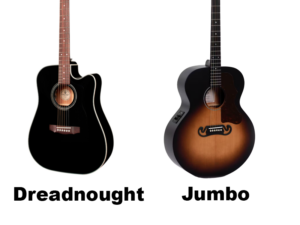 Dreadnought Guitar: The Dreadnought is a true icon, known for its bold and powerful sound. Its large body produces a strong bass response, making it ideal for strumming and vocal accompaniment.
Dreadnought Guitar: The Dreadnought is a true icon, known for its bold and powerful sound. Its large body produces a strong bass response, making it ideal for strumming and vocal accompaniment.This guitar is known for its powerful voice and lower-mid-rich tones that make it a favored choice for country artists. Although it is a popular choice for musicians of all genres.
Some famous musicians who play the dreadnought guitar include Hank Williams Jr, Elvis Presley, Keith Richards, Thom Yorke, and Kurt Cobain.
The original dreadnought guitars were made for the Oliver Ditson Company and featured mahogany backs and sides and spruce tops.
-
Jumbo Guitar: The jumbo guitar lives up to its name with a massive body that delivers robust volume and a deep bass presence.
This is the largest of the guitar family with a deeper body than the popular dreadnought. The body is wider and deeper than traditional acoustic guitars, which gives them a unique appearance.
Jumbo’s are well suited to rhythm guitarists in country and folk rock, and produce a deep rich sound favored by heavy strummers. Some famous musicians who play this guitar are Elvis Presley, George Harrison of the Beatles, Neil Young, Sheryl Crow, and Pete Townshend of The Who.
Choosing the Right Acoustic Guitar Size for You
Selecting the right acoustic guitar size involves considering factors such as playing style, comfort, and tonal preferences. Here are some steps to guide you on your quest:
-
Identify Your Playing Style: Determine whether you lean towards fingerpicking, strumming, or a mix of both. Different sizes excel in different playing styles, so choose one that complements your technique.
-
Consider Body Comfort: Hold and play guitars of various sizes to assess comfort. A guitar that fits well against your body ensures a pleasant playing experience, especially during extended sessions.
-
Evaluate Sound Preferences: Listen to the sound produced by different acoustic guitar sizes. Pay attention to tonal qualities, such as warmth, brightness, and projection, to find the one that resonates with your musical taste.
The Influence of Acoustic Guitar Sizes on Music
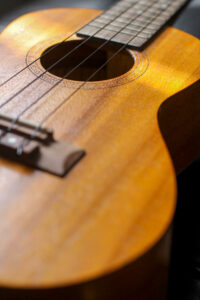 Acoustic guitar sizes and shapes can have a significant impact on the sound of the instrument.
Acoustic guitar sizes and shapes can have a significant impact on the sound of the instrument.The size of the guitar body type also relates to the volume of air within the instrument. Changes to the air capacity of the body will emphasize specific frequencies. A smaller body will have a more focused sound centered on higher frequencies, while a larger body will produce deeper low-end frequencies.
Body dimensions can provide some indication of the tone you might expect, but other factors exert a profound influence, too. Much depends on the tonewoods used to construct the body and the shape, size, and layout of the braces.
Finding Harmony in Acoustic Guitar Sizes
By delving into the nuances of size, sound, and playability, you’ve gained insights that will guide you toward the perfect fit for your musical aspirations.
As you continue your exploration, remember that each acoustic guitar size has its own unique voice and character. Embrace the joy of trying different sizes, celebrate the nuances of their sounds, and let your heart lead you to the one that resonates with your musical soul.
-
Uncategorized
Unveiling the Enchanting CM7 Guitar Chord: Your Key to Musical Expression
Hello, fellow guitar enthusiasts and music aficionados! Are you ready to delve into the captivating world of the CM7 guitar chord? Today, we’re embarking on a melodic journey that unveils the beauty and versatility of the CM7 chord – a harmonious gem that adds depth and sophistication to your musical repertoire. Whether you’re a budding guitarist eager to expand your chord knowledge or a curious soul seeking to understand the intricacies of harmony, this guide will introduce you to the enchanting universe of the “CM7 Guitar Chord.” So, pick up your guitar, find a comfortable spot, and let’s explore the harmonious tapestry of musical expression and creativity!
Discovering the CM7 Guitar Chord: A Harmonious Gem
Imagine the CM7 chord as a musical gem that radiates elegance and charm. This chord’s unique tonal quality infuses your music with a sense of warmth and richness, making it a versatile choice across various musical genres. Just like a painter mixing colors on a palette, the CM7 chord allows you to blend notes and create harmonies that resonate with emotion and creativity.
Mastering the CM7 Guitar Chord: Crafting Melodic Brilliance
Let’s dive into the mechanics of forming the CM7 chord on your guitar. Follow these steps:
1. Finger Placement: Begin by placing your index finger on the 1st fret of the B string (the second thinnest string), marking the root note (C).
2. Middle Finger: Position your middle finger on the 2nd fret of the D string (the fourth thickest string), forming the major third (E).
3. Ring Finger: Place your ring finger on the 3rd fret of the A string (the fifth thickest string), creating the perfect fifth (G).
4. Pinky Finger: Add your pinky finger to the 4th fret of the high E string (the thinnest string), completing the chord with the major seventh (B).
5. Strumming: Strum from the A string (the fifth thickest string) down to the high E string (the thinnest string), omitting the low E string (the thickest string) for a cleaner sound.
6. Sound Check: Strum the strings individually to ensure each note rings out clearly. Adjust finger placement if needed for a resonant sound.
Exploring CM7 Guitar Chord Variations: Adding Flair
While the CM7 chord is inherently elegant, you can add variations to elevate its sonic possibilities. Here are a couple of ways to experiment:
1. Add Arpeggios: Instead of strumming all the strings at once, try playing the notes of the CM7 chord individually in a sequence to create arpeggios that cascade like gentle waterfalls.
2. Fingerstyle: Experiment with fingerstyle picking to add intricate patterns and dynamics to your CM7 chord progressions.
The CM7 Guitar Chord in Action: Musical Styles
The CM7 chord’s rich and lush quality makes it a favorite choice for songs that evoke emotions and convey depth. Here are a few popular songs that feature the CM7 chord:
1. “Don’t Know Why” by Norah Jones: The CM7 chord contributes to the jazzy and soulful atmosphere of this timeless ballad.
2. “Tears in Heaven” by Eric Clapton: The CM7 chord adds a touch of melancholy and introspection to the song’s heartfelt melody.
Tips for Mastering the CM7 Guitar Chord
As you dive into the world of the CM7 chord, consider these tips to enhance your playing:
1. Practice Chord Changes: Work on transitioning smoothly between the CM7 chord and other chords to improve your overall playing fluency.
2. Experiment with Strumming Patterns: Try different strumming patterns to add rhythmic interest and variety to your CM7 chord progressions.
3. Use a Metronome: Practice with a metronome to develop a steady sense of rhythm and timing.
Conclusion: Embrace the Beauty of the CM7 Guitar Chord
Congratulations, you’ve embarked on a harmonious journey through the captivating universe of the CM7 guitar chord. As you strum, experiment with variations, and play songs, you’ll discover the power of this chord to infuse your music with elegance, emotion, and depth. Keep practicing, keep exploring, and keep embracing the enchanting allure of the CM7 chord. It’s your key to a world of musical expression, where each note resonates with grace and sophistication. So, pick up your guitar, let your fingers dance across the strings, and let the captivating world of the CM7 guitar chord lead you toward a realm of melodies that stir the heart and elevate the soul, one harmonious note at a time!
Uncategorized
Guitar String Letters: A Beginner’s Guide to Understanding the Musical Alphabet
Embarking on the journey of playing the guitar is an exciting endeavor filled with melodies waiting to be brought to life. To navigate this musical realm, it’s essential to understand the language of guitar string letters. These letters represent the names of the six strings on a guitar, each with its unique sound and character. In this article, we’ll take you through the basics of guitar string letters, their significance, and how they contribute to creating beautiful music. So, let’s dive into the world of guitar string letters and unlock the key to playing harmonious tunes!
Cracking the Code of Guitar String Letters
The guitar’s six strings are named after the musical alphabet – A, B, C, D, E, and F – each with its distinct pitch and tone. Understanding these letters is fundamental to identifying the strings and playing chords, melodies, and songs. Let’s take a closer look at each guitar string letter and its role in shaping the guitar’s sound.
1. E String (6th String): The lowest-pitched string is the E string, located closest to your chest when holding the guitar. It produces deep, resonant tones that lay the foundation for basslines and powerful chords.
2. A String (5th String): Moving up, we encounter the A string. With a slightly higher pitch than the E string, the A string contributes warmth and balance to your playing.
3. D String (4th String): Next in line is the D string, which adds a melodic quality to your sound. It’s versatile and often used for crafting intricate melodies and solos.
4. G String (3rd String): The G string introduces a brighter and more vibrant timbre. It’s a favorite for crafting lively and dynamic guitar parts.
5. B String (2nd String): As we ascend the musical ladder, we reach the B string. Its higher pitch offers a sweet and delicate sound, perfect for adding an ethereal touch to your music.
6. High E String (1st String): The highest-pitched string is the high E string, which produces the most delicate and shimmering tones. It completes the guitar’s sonic spectrum, allowing you to reach soaring highs.
Importance of Guitar String Letters
Understanding guitar string letters is crucial for several reasons:
1. String Identification: Guitar string letters help you quickly identify and locate the strings, ensuring accurate finger placement while playing.
2. Chord Formation: Knowing the string letters is essential for forming chords correctly, enabling you to create harmonious and balanced chord voicings.
3. Melody Creation: When playing melodies and solos, recognizing the string letters guides you in producing clear and precise notes.
Practical Tips for Learning Guitar String Letters
Here are some practical tips to help you become familiar with guitar string letters:
1. Visualize and Memorize: Visualize the order of the strings and their corresponding letters. You can create mnemonic devices or memory aids to help you remember the sequence.
2. Say the Letters Aloud: As you practice playing, say the names of the strings aloud. This verbal reinforcement reinforces your memory.
3. String-by-String Approach: Focus on one string at a time. Play open strings while saying their names, gradually moving from the low E string to the high E string.
4. Use a Reference Chart: Keep a reference chart or diagram of the guitar strings and their letters handy for quick reminders during practice.
Unlocking the Potential of Guitar String Letters
Mastering the art of guitar string letters opens the door to a world of musical exploration. As you become familiar with the sounds and characteristics of each string, you’ll gain the confidence to create captivating melodies, strum harmonious chords, and craft intricate solos. With every note you play, the guitar string letters will guide your fingers and inspire your musical journey.
As you continue your path of learning and playing, remember that practice is key. Embrace the joy of discovering new sounds, celebrate your progress, and let your passion for music light the way. With consistent effort and a love for playing, you’ll find yourself effortlessly navigating the guitar’s fretboard, expressing your emotions through beautiful melodies, and sharing the gift of music with the world.
So, pick up your guitar, honor the guitar string letters, and let your musical creativity soar. With your newfound knowledge, you’re well-equipped to embark on a harmonious adventure that resonates with the magic of guitar string letters. Happy playing!
-
advanced8 years ago
How to Play “Sleepwalk” on the 3-String Guitar! Guitar TABs Included!
-
beginner8 years ago
3-String or 4-String? How to Decide Which is Right for You!
-
Blues Guitar8 years ago
Go-To Tunings for Blues Slide Guitar
-
advanced8 months ago
Fun and Effective Guitar Exercises: Elevate Your Playing with These 5 Simple Techniques
-
beginner8 months ago
Exploring Different Guitar Types: A Beginner’s Guide
-
Blues Guitar7 years ago
Jack Daniel’s Whiskey Barrel Guitar: How It’s Made and What it Sounds Like
-
Guitars8 months ago
Bass vs Guitar: Exploring the Musical Journey
-
Uncategorized8 months ago
Acoustic Guitar Sizes: Finding Your Perfect Fit
